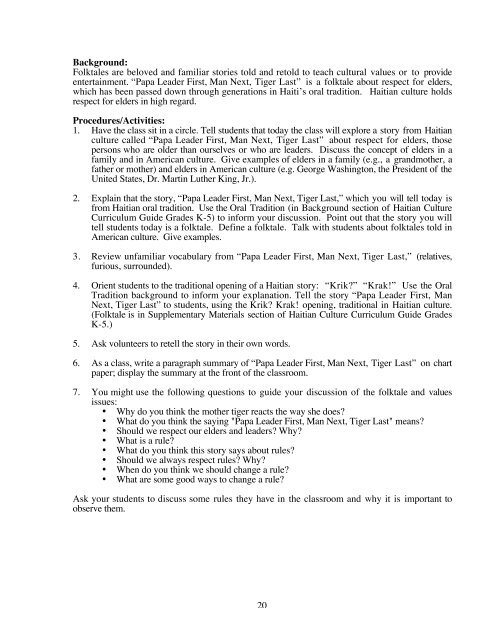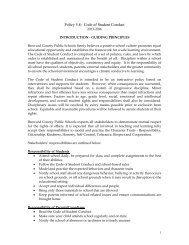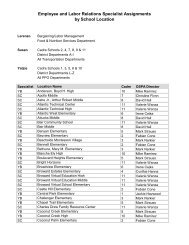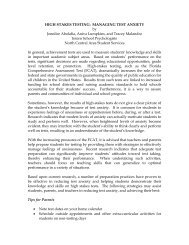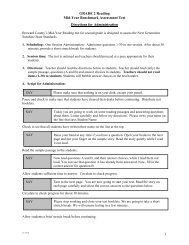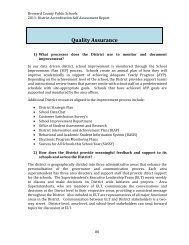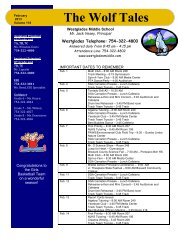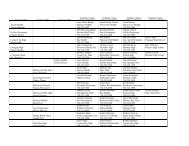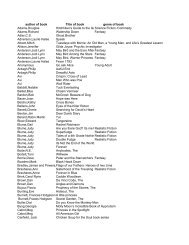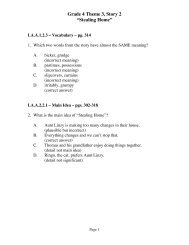Haitian Culture Curriculum Guide
Haitian Culture Curriculum Guide
Haitian Culture Curriculum Guide
You also want an ePaper? Increase the reach of your titles
YUMPU automatically turns print PDFs into web optimized ePapers that Google loves.
Background:<br />
Folktales are beloved and familiar stories told and retold to teach cultural values or to provide<br />
entertainment. “Papa Leader First, Man Next, Tiger Last” is a folktale about respect for elders,<br />
which has been passed down through generations in Haiti’s oral tradition. <strong>Haitian</strong> culture holds<br />
respect for elders in high regard.<br />
Procedures/Activities:<br />
1. Have the class sit in a circle. Tell students that today the class will explore a story from <strong>Haitian</strong><br />
culture called “Papa Leader First, Man Next, Tiger Last” about respect for elders, those<br />
persons who are older than ourselves or who are leaders. Discuss the concept of elders in a<br />
family and in American culture. Give examples of elders in a family (e.g., a grandmother, a<br />
father or mother) and elders in American culture (e.g. George Washington, the President of the<br />
United States, Dr. Martin Luther King, Jr.).<br />
2. Explain that the story, “Papa Leader First, Man Next, Tiger Last,” which you will tell today is<br />
from <strong>Haitian</strong> oral tradition. Use the Oral Tradition (in Background section of <strong>Haitian</strong> <strong>Culture</strong><br />
<strong>Curriculum</strong> <strong>Guide</strong> Grades K-5) to inform your discussion. Point out that the story you will<br />
tell students today is a folktale. Define a folktale. Talk with students about folktales told in<br />
American culture. Give examples.<br />
3. Review unfamiliar vocabulary from “Papa Leader First, Man Next, Tiger Last,” (relatives,<br />
furious, surrounded).<br />
4. Orient students to the traditional opening of a <strong>Haitian</strong> story: “Krik?” “Krak!” Use the Oral<br />
Tradition background to inform your explanation. Tell the story “Papa Leader First, Man<br />
Next, Tiger Last” to students, using the Krik? Krak! opening, traditional in <strong>Haitian</strong> culture.<br />
(Folktale is in Supplementary Materials section of <strong>Haitian</strong> <strong>Culture</strong> <strong>Curriculum</strong> <strong>Guide</strong> Grades<br />
K-5.)<br />
5. Ask volunteers to retell the story in their own words.<br />
6. As a class, write a paragraph summary of “Papa Leader First, Man Next, Tiger Last” on chart<br />
paper; display the summary at the front of the classroom.<br />
7. You might use the following questions to guide your discussion of the folktale and values<br />
issues:<br />
• Why do you think the mother tiger reacts the way she does?<br />
• What do you think the saying "Papa Leader First, Man Next, Tiger Last" means?<br />
• Should we respect our elders and leaders? Why?<br />
• What is a rule?<br />
• What do you think this story says about rules?<br />
• Should we always respect rules? Why?<br />
• When do you think we should change a rule?<br />
• What are some good ways to change a rule?<br />
Ask your students to discuss some rules they have in the classroom and why it is important to<br />
observe them.<br />
20


